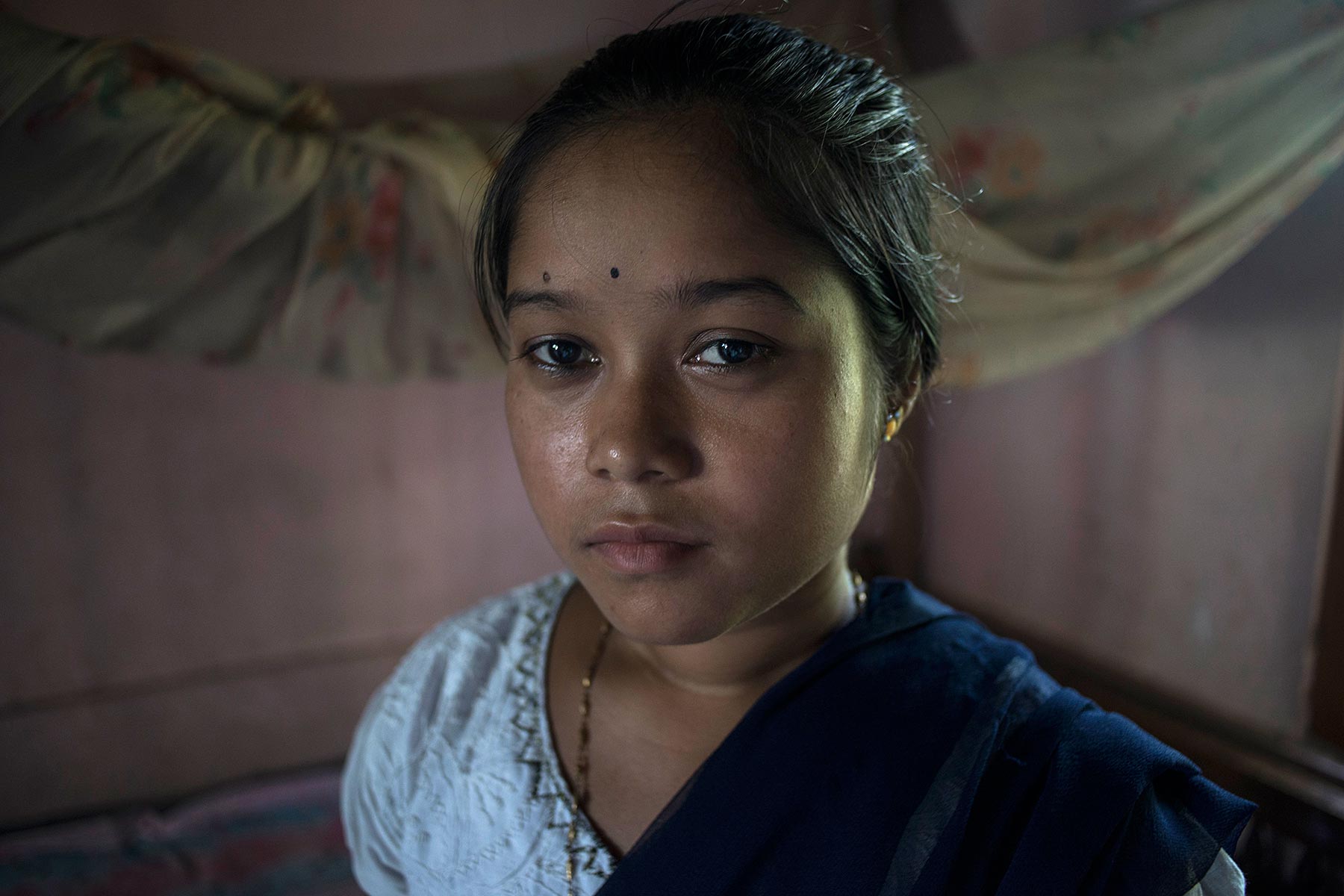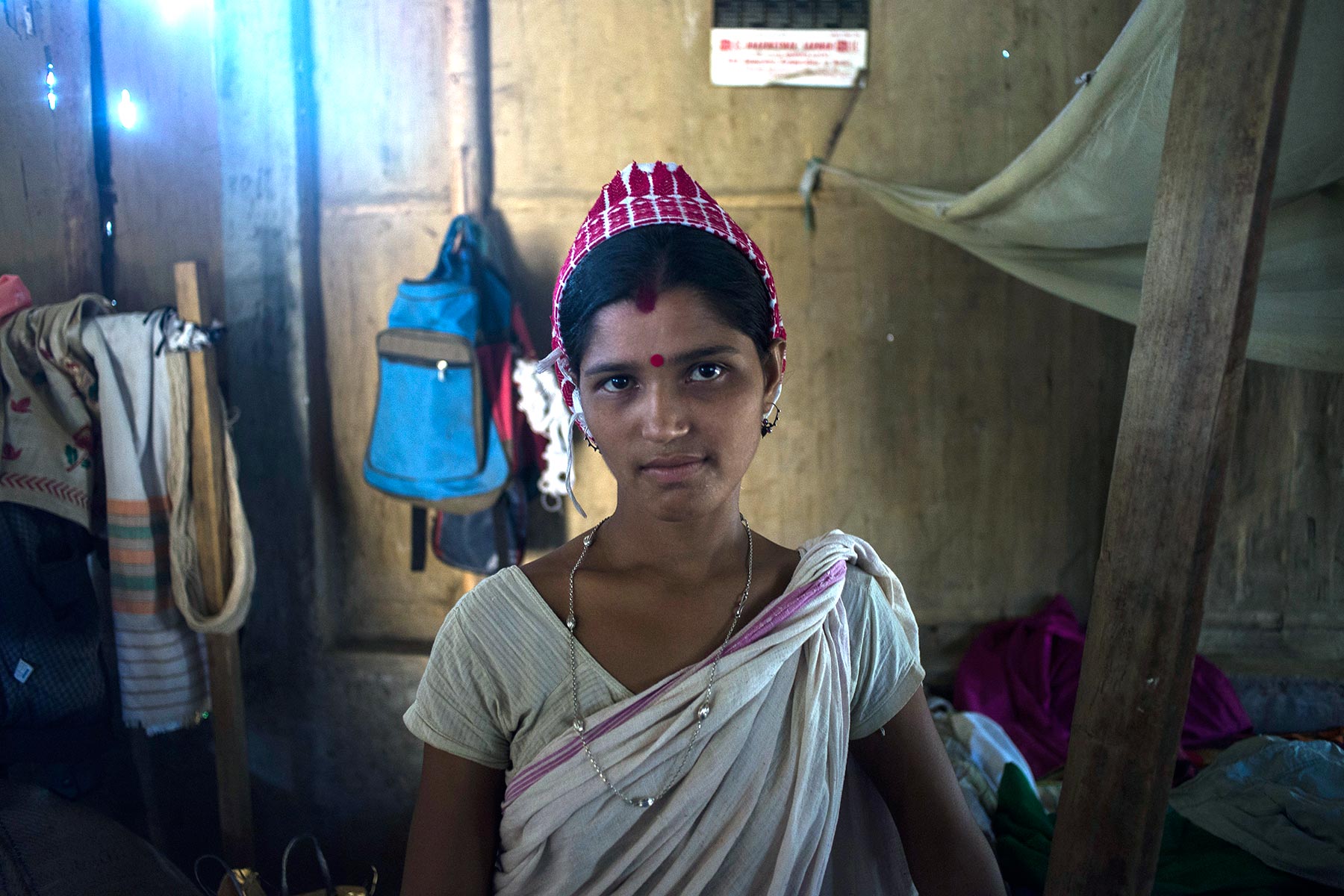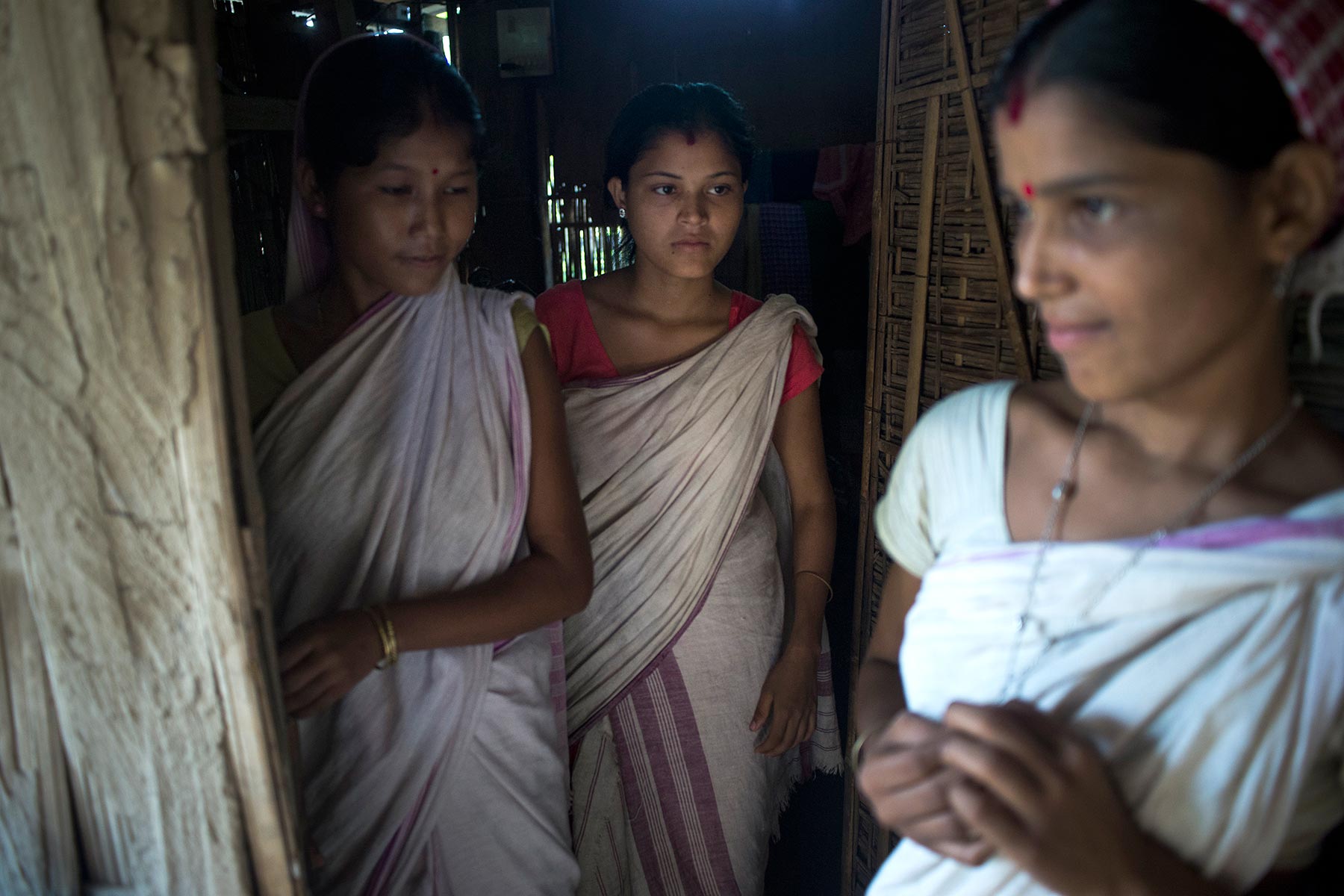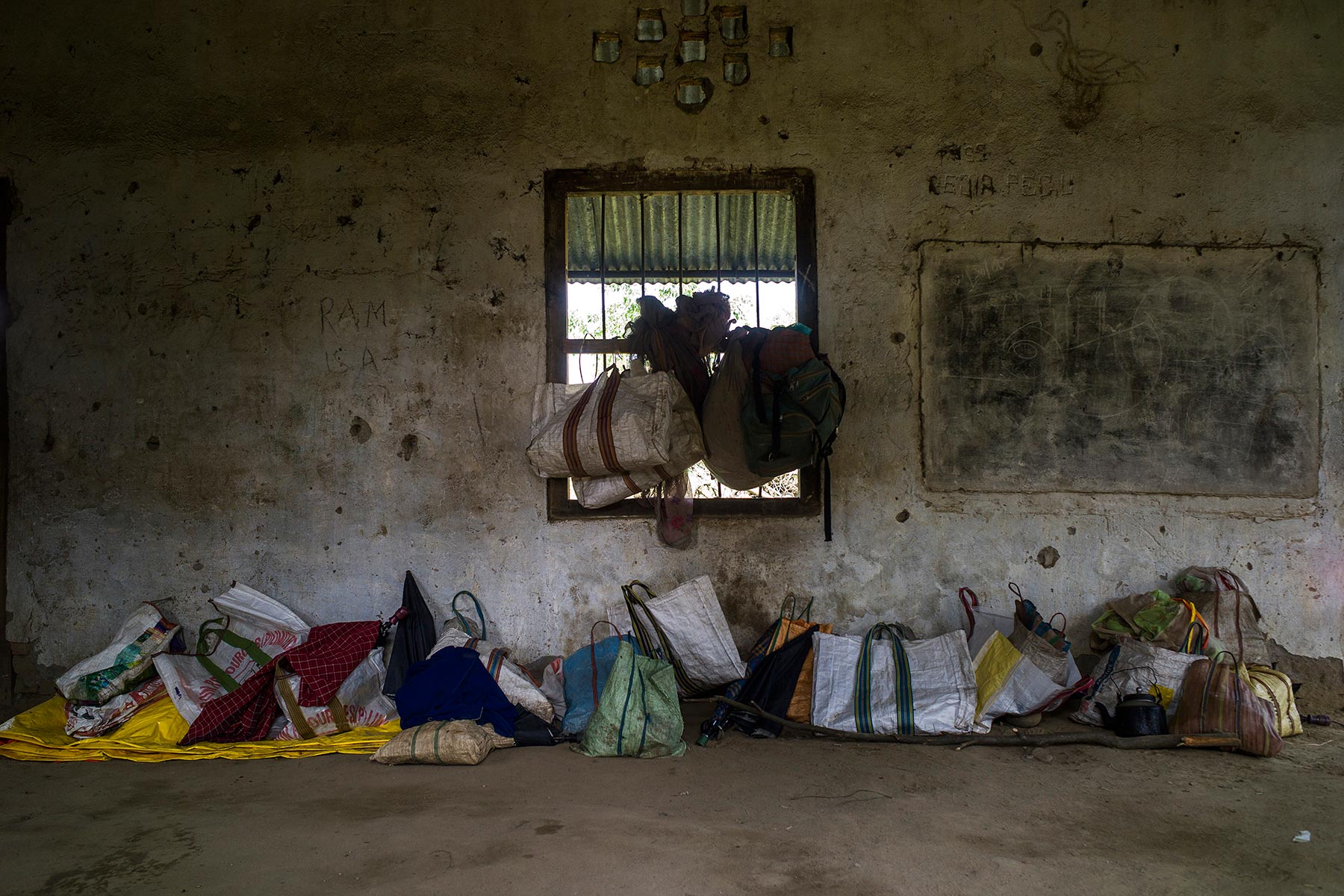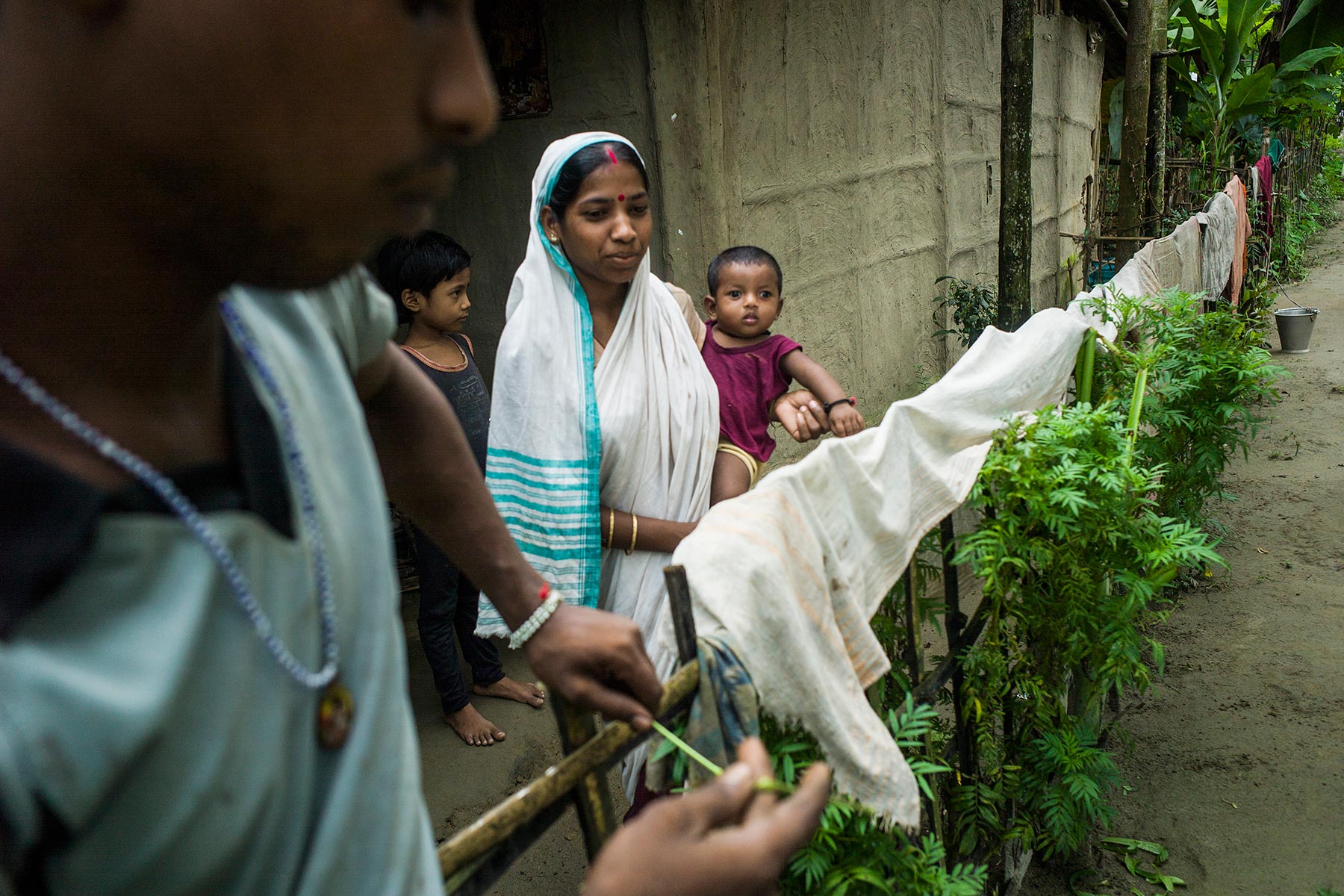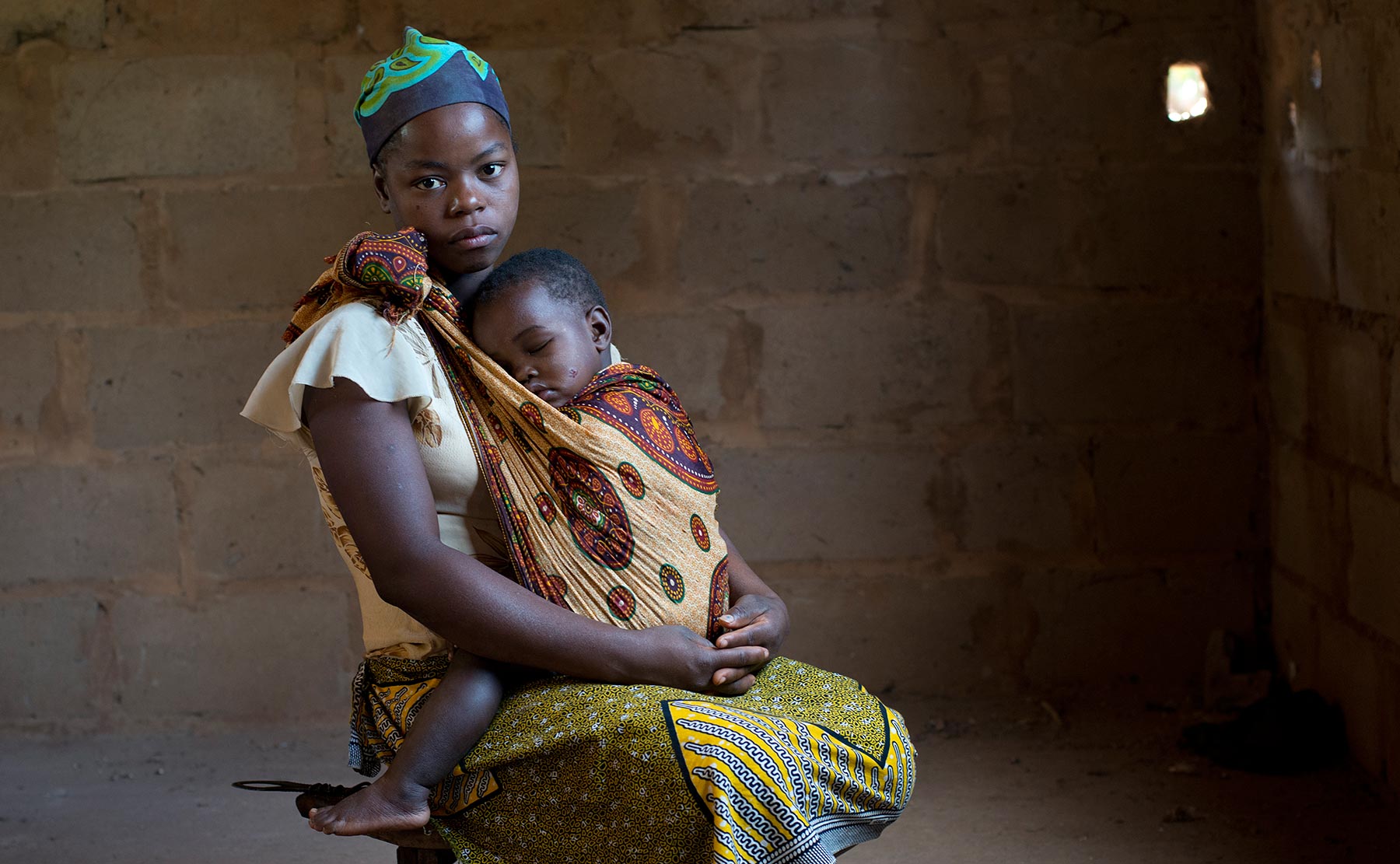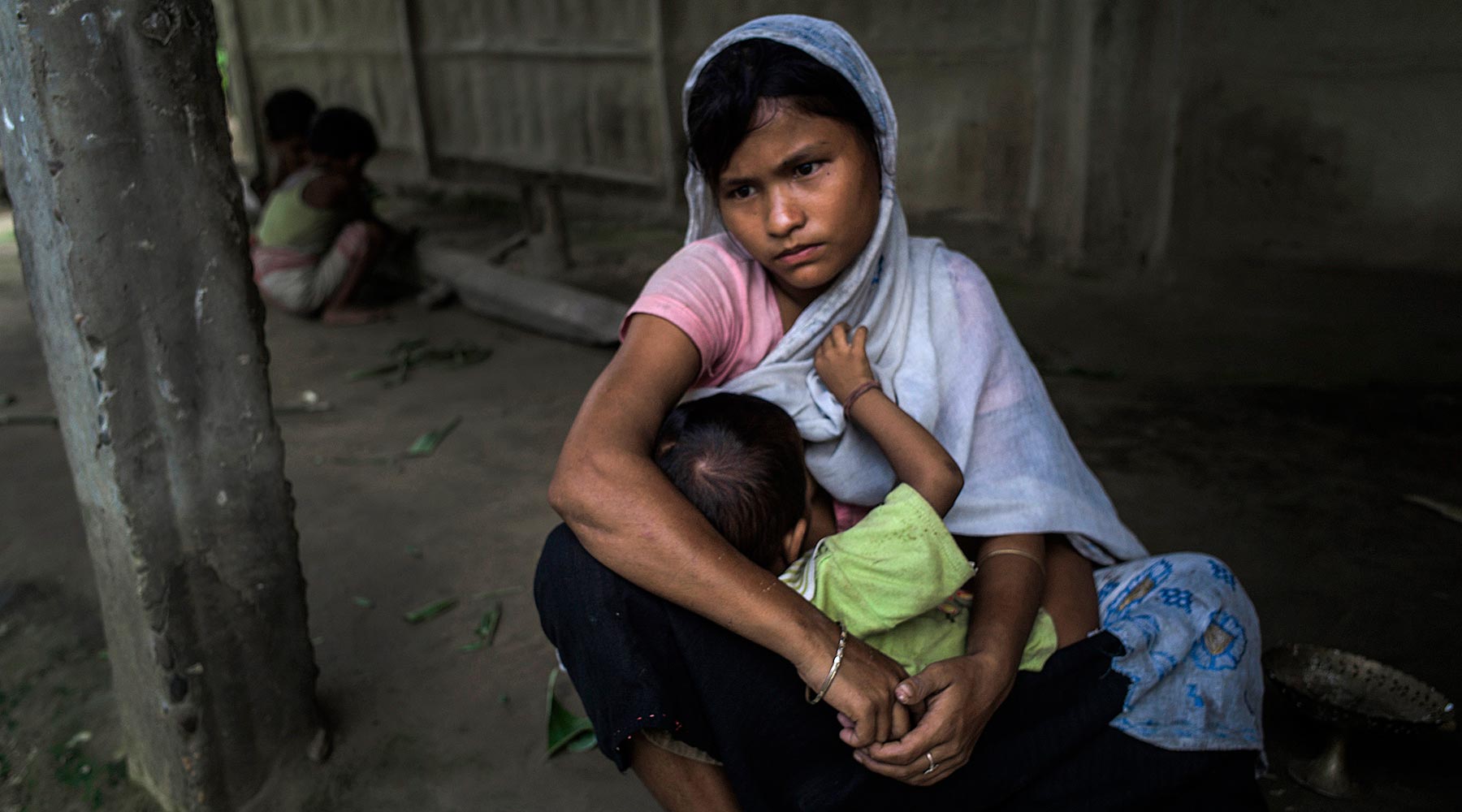
Troubled Waters
Child brides in flood-ravaged Assam, India
Series
This is the second in an occasional series on child marriage.
Returning from her neighbor’s hut, 17-year-old Debjani Das scampered across a slim bamboo bridge over muddy rainwater that surrounded her home, nimbly placing bare, clay-caked feet one in front of the other. Clouds were rumbling, and the August afternoon was sure to be drenched in rain. She pulled her frayed chador over her head and used her free hand to hoist her 10-month-old boy on her hip. A 3-year-old daughter followed, sucking on a red berry — her meal for the day. Debjani’s 18-year-old husband, Chitro, crouched in front of their house, seemingly unaffected by the steady drizzle. He was cutting wood to build a footbridge. The monsoon was upon them, and a deluge was imminent.
Four years ago, Debjani became a wife on a rain-soaked day like this one. It was after the severe floods of 2008, and her family was living in a relief camp. There was no ceremony, just a simple lunch that her father arranged for the villagers. She wore a borrowed silk mekhla-chador and was both nervous and excited. Her surname did not change — her husband belongs to the same Dalit caste as she does — and it is now her only reminder of her maternal home. Now she lives in a two-room hut in Botha Doi, her husband’s village in the Dhemaji district, neighboring the one she grew up in.
In the northeastern state of Assam but also across the rest of India, the number of underage couples like Debjani and Chitro is not falling fast enough. Early marriage is especially common among chronically poor, marginalized groups, says UNICEF’s child protection specialist in Assam, Ved Prakash Gautam. The most vulnerable, he says, include those living in “low-lying areas and flood-prone villages,” an assessment borne out by a May 2014 study by two women’s empowerment nonprofit groups, the Nirantar Trust and Sadbhavna Trust.
The study found that in addition to gender disparity and poverty, natural disasters such as floods and conflicts like the 2013 riots in Muzaffarnagar in Uttar Pradesh increase early marriage. And floods have the secondary effect of discouraging continued education for girls, which is associated with later marriage.
Areas of upper Assam that fall in the Brahmaputra Valley, including the districts of Dhemaji and Lakhimpur, have recorded some of the highest instances of early marriages since the 1980s. These are the same areas that are prone to inundation every monsoon; last year they faced severe floods that affected roughly 100,000 people.
In moments of unbearable financial or social distress, the study found, flood-affected families have increasingly resorted to marrying their daughters off — the sooner the better — in a bid to protect them from more instability and hunger. With the social pressure on the patriarch to be responsible for the safety of women in his household and the notion that the family’s honor is linked with female chastity, the odds are stacked against daughters.
Source: District Level Household and Facility Surveys, 2007-2008 and 2012-2013. Map uses most recently available data, but nine Indian states have not yet published data for 2012-2013. In these cases, map uses 2007-2008 figures.
In India, the legal age for marriage is 18 for girls and 21 for boys, but this threshold is widely disregarded in practice. In a 2014 global report on child marriage, UNICEF found that India is home to 1 in 3 of the world’s child brides. The Indian government’s 2005–06 family health survey, the latest available, finds that about 47 percent of girls 20 to 24 years of age were married or had entered into a union before the legal age. In Assam, this is true for about 39 percent of women. (The survey defines marriage as cohabitation, which includes diverse community practices.) More than 16 percent became mothers or were pregnant by the age of 18.
Botha Doi paints a glum picture of this situation. New brides here — chadors covering their hair, vermillion on their foreheads and often nursing an infant — are, without exception, younger than 18.
Nationally, legal penalties, education and awareness programs have reduced the marriage rate of girls under 15 years by 30 percent from 2000 to 2011, but marriages of girls under 18 fell by only 13 percent. Early marriage, as unions of teenagers are classified, is persistent.
Debjani is no exception: She was only 13 when she was married off to Chitro after floods ravaged her village. Her father worked for a daily wage on paddy fields; her mother left for Guwahati, Assam’s capital, to work as domestic help and stayed on with another man. “As the oldest girl, the household responsibilities fell on me,” she says bitterly. She cooked all the meals, cleaned the house, dehusked paddy, collected firewood, cared for her sick grandmother and tended to the goats. Soon her attendance at school became erratic, and in 2008, after she hit puberty, she dropped out. That year, the paddy fields were waterlogged again, her father couldn’t find work, and the family moved to a flood relief camp. Her older brother was sent to clean tables at a hotel in Guwahati, where he met Chitro. Before she knew it, her father was arranging her wedding to her brother’s friend.
“They wanted one less mouth to feed,” she says of her father and brother. “I didn’t protest. Girls don’t get to do that.” She found Chitro handsome and thought that as a wife, she might have more agency than she did as a daughter. But even after marriage, she continues to do the household and farm chores in addition to raising two children. “Such is life,” she says, shrugging.
Chitro’s parents made sure his two sisters tied the knot when they were in the seventh and sixth grade, moving them to marital homes in drier southern districts. They wanted him to marry early too. “I couldn’t afford to have him waste time with childish things like affairs and wandering,” says Chitro’s father, a rickshaw puller. He rationalized marriage as the surest step into adulthood, one that would shield his boy from distractions, premarital sex and unpredictable adolescent behavior. According to the early marriage study, the family patriarch often marries off teen boys to start them early on the course to manhood and responsibility. While their young wives become extra hands in the household and on the farm, the boys are expected to start earning an income.
As soon as Debjani became pregnant, Chitro moved west to Mumbai to work in a hotel. Now that he is 18, he has found better work in a factory in the southern state of Kerala, where daily wages are four times higher than in Assam. Still, they say they never make enough.
The Indian government passed the Prohibition of Child Marriage Act in 2006, increasing penalties for conducting marriage ceremonies for underage couples and making marriages open to annulment by either spouse for up to two years after reaching legal age. The law has contributed to reducing child marriages overall, but Runumi Gogoi, the chairwoman for Assam’s Commission for Protection of Child Rights, says that early — as opposed to child — marriages are trickier to identify, report and prevent.
One reason for this is that in rural Assam, as in villages all over India, age is rarely known with any certainty. Because of illiteracy, home birthing and lack of awareness, birthdates are rarely recorded or are often inaccurate. “People look for signs. They don’t count numbers,” says Nabajyoti Dutta, who runs the Socioeconomic Development Organization in Dhemaji, which works with rural health, farming and flood relief. “A boy in eighth grade is assumed to be around 13 or 14. The sprouting of a moustache means he’s about 16. A girl who hits puberty is assumed old enough for marriage. Actual age is irrelevant.”
Puberty is widely considered to be the onset of fertility and therefore eligibility for marriage. Most teen girls become pregnant — indeed, society expects them to — soon after they tie the knot. In Assam, 16 percent of girls ages 15 to 19 were already mothers; of these, 30 percent were uneducated. In three of four households, the first child was born to a teen mom.
In Simen Koibatra village on the banks of the River Simen, a government teacher tests preschoolers for malnutrition every year under a state-funded program. “Every one of them is underweight, undernourished and has frequent diarrhea,” she says of the 25 in school. “Their mothers are around 16 to 17 years of age.” All the teen moms were from flood-affected districts.
Across Dhemaji and Lakhimpur, most school buildings during the monsoon are teeming not with students but entire families displaced by waterlogging or floods. Often the only large concrete structures in the villages, schools become flood relief camps almost by default. Classes are suspended, the benches moved out and families moved in until the water recedes.
In the town of Simen Chapori, an emptied-out high school shelters about 150 families from the Missing tribe who come from the nearby village of Narayanpur. The tribe traditionally lives in riverine deltas and builds bamboo homes on stilts. During a recent flood, when the roads collapsed and water gushed into the village, the district flood relief commissioner ordered an evacuation.
“This is the moment in which the number of dropouts soars,” says Ritamani Gogoi, a field worker at the Assam Mahila Samata Society (AMSS), a state-run women’s rights nonprofit. “Schools close, kids are moving around with the displaced families, or they have to start working.”
Two out of five students drop out by the eighth grade in Assam; among marginalized groups, it is double that number. “Many girls believe that without an education, their only option is to get married,” says Gogoi. It’s a notion reinforced by the patriarchal structure of the society. The UNICEF report found that about 7 in 10 married girls in Assam had no education, and among schoolgoing girls, every second one had dropped out by the 10th grade.
Sixteen-year-old Happy Moran and her three friends are aberrations. In the flood relief camp in Simen Chapori, amid a flock of women nursing babies or cooking, they are among the few adolescent girls from Narayanpur who still go to school.
“I too dropped out after seventh grade, after, you know, it happened,” admits Happy, referring shyly to her menarche. But before she could be married off, the AMSS enrolled her in what it calls a rehabilitation school for girl dropouts. This was part of a visionary but short-lived state program to prevent early marriages.
A state-employed midwife in the Dhemaji hospital said on condition of anonymity that most first pregnancies in the village are among married, underage teenagers. But in the hospital’s records, they’re registered as 18 years old. “They’re married, so it is not registered as teenage pregnancies,” the midwife says. Miscarriages and medical abortions are frequent, she adds, but, paradoxically, are rarely recorded because of their prevalence.
Ahami Das of Simen Koibatra had two of these unrecorded miscarriages. Her mother, Niromani, arranged Ahami’s wedding to a boy “from a good family,” Niromani says. His people were affluent, urban and from a less frequently flooded town. Ahami was 15. Two years later, Ahami had been pregnant twice; neither of the fetuses survived. The first time, she almost bled out at home because of complications, but no one informed her mother or summoned medical help. Conceiving again at 16, Ahami delivered a stillborn baby at home. When her mother-in-law did not call the hospital, a gravely sick Ahami called Niromani, who took her back immediately.
Pale and hardly able to stand, Ahami says her husband, now 23, has already found another teen bride. (With the marriage being illegal and, like most rural marriages, not registered with the courts, separation and remarriage are common.) For the moment, Niromani is giving her daughter time to recover, but she’s uneasy. “To have an unmarried 17-year-old at home is so rare and nerve-racking. Despite the girl’s trauma, I am always on the verge of giving in to another wedding,” she says. Ahami suggests that she re-enroll in high school instead, but her mother dismisses it as “a useless idea.”
Since June — the beginning of the school year and pre-monsoon — another AMSS field worker, Shanima Das, and her team have been visiting girls’ homes to convince their parents to wait longer before marrying their daughters off. “Most of the parents told us to mind our own business,” she says. “But some agreed to send the girls back to school if we taught them how to use computers.”
Despite their efforts, after the punishing August deluge, the AMSS register showed that the number of girls in high school was halved in two months. “Many boys come back, but most girls never will,” Gogoi says. She can counsel the parents, but far too often, she explains, the uncertainty caused by floods pushes families to offload “burdens” — as teenage girls are seen — to ensure stability.
Many girls see early marriage as an inevitability. Happy reveals that in her new class of 25, over the last month, six girls have “disappeared.” She does not sound surprised or upset. “It happens,” she says. “Some of them must’ve gone with their boyfriends.”
Customarily, families start to hunt for grooms as soon as their daughters hit puberty. So as one young mother, Rumi Saro, says, “We girls try to find a boy for ourselves before our father does.” Often these boys are only a few years older. In Assam, people tend to call this “running away to get married,” a phrase loaded with cultural prejudice against any relationship not fixed by the family.
Marrying boys of their choice allows the girls’ families to avoid large wedding expenses and gives the teens a semblance of control over their future. But as Gogoi points out, “These are uneducated children making immature choices too early in their lives.”
As more teens enter into relationships, their conservative families react in the only way they know: by converting their child’s first relationship with the opposite sex — sexual or friendly — into marriage. “They just get their daughter married to the first boy they see them talking to or intervene with a groom of their own choice,” says Dutta.
Although there is evidence to show the connections between flood-related distress and early marriage, the programs that address these problems rarely interact. Luit Goswami of the Rural Volunteers Centre, which works on flood preparedness in Assam, says that most flood-relief policies tend to focus on immediate concerns such as hygiene and housing. “It is horrible that floods should become such a regular part of life. We need environmental solutions,” Goswami says. “But flood-relief work needs to also recognize social fallouts, like increasing early marriage and broken families.”
Until then, it is perhaps the young couples that must go against the grain. Moon Das, a 14-year-old mother of an infant girl, has entered into a pact with her 16-year-old husband, Jogen. “Look, how cute,” Moon says, cooing at the baby and kissing her little nose. “We will keep our daughter in school,” she says. Jogen says that excessive rain has made agriculture undependable in the area and that the only way to get a job in the future will be through education. “Our days have gone like this,” he says, “but we are going to remember it shouldn’t happen to our baby.”

